 |
|
|
|
|
|
|
|
 |
IT Barrier-Free project for Disabled Personas and other Users |
|
|
A.Project outline |
| The purpose of the project is to develop a user terminal of mobility support system for disabled persons designed to ensure compatibility and inter-operability with existing systems. |
Measures to assist mobility are fundamental to actively promoting the participation in society of people with visual and other disabilities, and are one of the most important from of support available. But while a variety of mobility support systems have been developed and put into operation individually, the piecemeal manner in which this has occurred has given rise to numerous problems regarding their inter-compatibility and convenience. The purpose of this project is to develop and standardize common specifications for a user terminal enabling the integrated use of these systems, leading to their wider practical application and encouraging uptake. |
 |
page top |
B.Purpose and significance of project |
1.Development of a user terminal compatible with existing systems
Development of a user terminal allowing putting all the main pedestrian mobility support systems into a single terminal.
2.Adoption of new technology and systems
Active incorporation of new technologies into systems, such as radio frequency identification (RFID) positioning technology and cellular phones.
3.Standardization of specifications and standards
Pursuit of activities to standardize specifications and standards in order to assist smooth and efficient research and development and ensure swift Analysis toward putting to practical use of systems, and promote their uptake. |
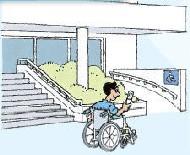
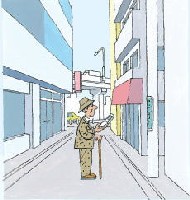 |
page top |
C.Use of existing techonologies and incorporation of new technologies |
|
|
|
As well as making active use of existing technologies in relevant fields. (such as IR and FM waves), new technologies such as GPS and RFID, cellular phones and the internet will also actively incorporated.
|
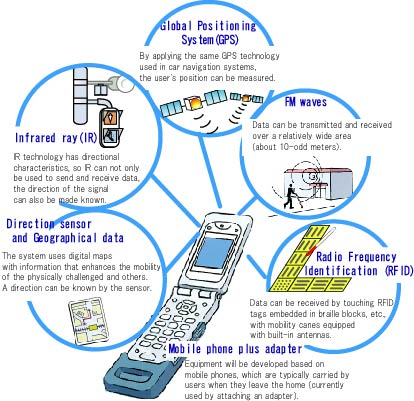
magnify
|
|
The new system will enable access from a single terminal to the main pedestrian mobility support systems using IR and Fm wave, a number of which have already entered use.
Use will also be made of technologies such as RFID tagging (using IC chips for wireless data exchange) built into induction blocks and GPS for accurately measuring one's position using signals transmitted from satellites so as to guide users to their desired destinations, and provide warnings about dangerous sports and information on the surrounding area, In addition, it will be made possible to obtain various information online using the internet.
The plan is to build this functionality into a cellular phone in the future so that the user can easily carry the terminal on his or her person at all times.
|
|
page top |
D.Concrete action undertaken for project |
| For the project, a system employing a user terminal designed to be easily usable by users with a variety of disabilities will be developed, trialed and empirically evaluated. |
1. Ensuring the compatibility and inter-operability of mobility support systems
The piecemeal manner in which mobility support systems have been developed ad introduced to date has given rise to problems regarding their compatibility and convenience from a user perspective and for this project, therefore, a user terminal will be developed to ensure the compatibility and inter-operability of existing system.
2. Use of existing technologies and incorporation of new technologies
As well as making active use of existing technologies in relevant fields, (such as infrared ray (IR) and frequency modulation (FM) wave, new technologies such as the Global Positioning System (GPS) and RFID, cellular phones and the internet will also be actively incorporated.
3.Collaboration with related ministries and agencies
Action will be taken with a view to reducing the cost of investment in development, infrastructure and smooth introduction of systems through collaboration with research bodies and related ministries and agencies, such as the National Police Agency, Ministry of Internal Affairs and Communications, Ministry of Land, Infrastructure and Transportation.
4. Measures to assist swift translation into practical use
In order to achieve qualitative improvements in project outcomes and assist swift translation into practical use, demonstration and evaluation trials will be conducted at the ITS World Congress (in autumn 2004) and the Aichi Expo (spring-autumn 2005)
|
page top |
E.Measures to achieve swift practical application |
|
This project is being undertaken over a four-year period form fiscal 2003 (April〜March) to fiscal 2006. As well as developing a user terminal and creating opportunities for its evaluation by users, activities well also be pursued with a view to standardization.
|
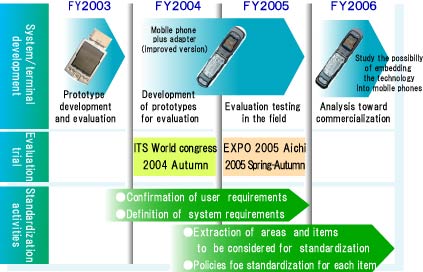
magnify
|
page top |
F.Framework for implementation of project |
|
The IT Barrier-Free Project for Disabled Persons and Other Users NEC Consortium will be commissioned by the Japanese Ministry of Economy, Trade and Industry (METI) and the New Energy and Industrial Technology Development Organization (NEDO) to implement the project; a project leader will lead whish. In addition, various committees, including a development committee, will be established in order to provide advice and give their expert opinion regarding the project.
|
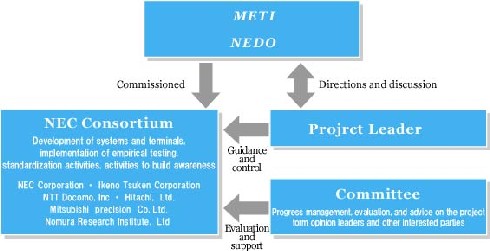 |
page top |
 |
| |
|
| |
